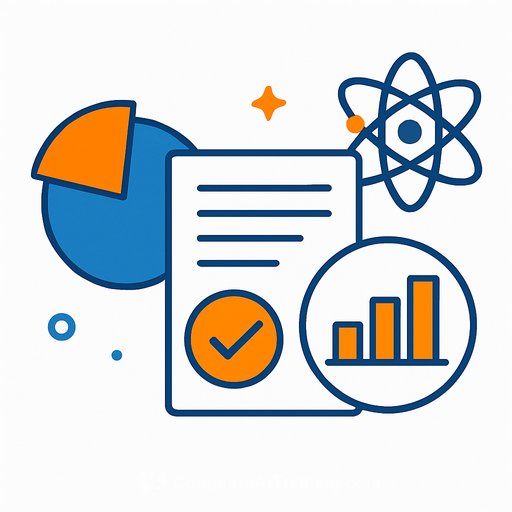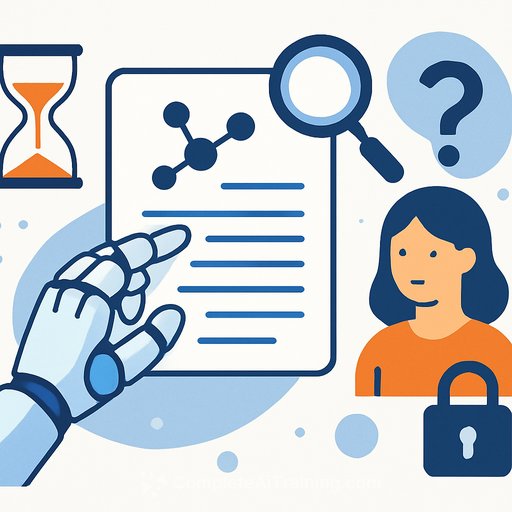90% of science is lost. A new AI turns it into reusable knowledge
Date: October 13, 2025 - Source: Frontiers
Most research data never gets reused. Out of 100 datasets, ~80 stay inside the lab, ~20 are shared but seldom used again, fewer than two meet FAIR standards, and only one typically drives new findings. That drag shows up as slow cancer breakthroughs, weaker climate evidence, and irreproducible studies.
What FAIR² Data Management does
Frontiers FAIR² Data Management is an AI-powered, end-to-end service that turns raw datasets into reusable, verifiable, and citable assets. It unites curation, compliance checks, AI-ready formatting, peer review, interactive visualization, certification, and permanent hosting in one workflow.
It builds on the FAIR principles (Findable, Accessible, Interoperable, Reusable) and extends them so data is ready for both humans and machine agents. The result: a practical, scalable way to convert today's research output into tomorrow's published, trusted, and reused data products.
AI at the center
The AI Data Steward from Senscience automates work that used to take months: organizing files, verifying integrity, generating metadata, and producing publishable outputs. Submission yields four integrated deliverables.
- Certified Data Package with standardized structure, metadata, governance, and quality checks.
- Peer-reviewed, citable Data Article to capture methods, provenance, and reuse notes.
- Interactive Data Portal with visualizations and an AI chat interface for exploration.
- FAIR² Certificate to signal reuse readiness and compliance.
Each element comes with clear summaries for non-specialists and cross-disciplinary compatibility, so datasets can be combined with confidence. Visibility improves, access is simple, and credit flows to the people who create and share the data.
Flagship pilot datasets
- SARS-CoV-2 Variant Properties: 3,800 spike protein variants linking structural predictions from AlphaFold2 and ESMFold with ACE2 binding and expression data for preparedness and variant fitness analysis.
- Preclinical Brain Injury MRI: 343 diffusion MRI scans harmonized across four centers for reproducible biomarker discovery and cross-site analyses.
- Environmental Pressure Indicators (1990-2050): Observed and modeled data across 43 countries tracking emissions, waste, population, and GDP-built for sustainability benchmarking and policy planning.
- Indo-Pacific Atoll Biodiversity: Data from 280 atolls integrating biodiversity records, reef habitats, climate indicators, and human-use histories to guide conservation and ecological modeling.
Scientists testing the pilots reported stronger confidence in reuse thanks to objective quality checks, clear non-specialist summaries, and reliable cross-dataset compatibility. All pilots comply with the FAIR² Open Specification for responsible, long-term human and machine use.
Why this matters for your lab
If your team generates high-value datasets, FAIR² compresses the path from "files on a shared drive" to "peer-reviewed, cited, and reused." It supports data management plans, reproducibility, and policy impact while ensuring contributors are recognized.
Practical steps you can apply now
- Treat datasets as first-class research outputs. Assign persistent identifiers and plan citations in advance.
- Adopt community standards for formats, metadata, and ontologies. Publish clear licenses and usage constraints.
- Ship a short, plain-language data summary plus a QC report. Make it easy for non-domain experts to assess fit.
- Plan data sharing at study design. Capture provenance, code, and parameters as you go.
- Provide an interactive view (or portal) so users can explore before they download.
Recognition and reuse
Every reuse compounds the value of the original dataset. FAIR² makes citation and credit routine, so data creators see tangible recognition-and society sees faster progress in health, sustainability, and technology.
What researchers are saying
- "This kind of data curation and data-article publication lets you generate useful information quickly in a format end users can work with." - Dr. Ángel Borja
- "FAIR² captured the scientific aspects of the project accurately." - Erik Schultes
- "It smooths execution of FAIR principles and proves reusable health datasets don't have to be complex." - Femke Heddema
- "Objective checks for missingness and quality help non-experts and enable data combination across sub-disciplines." - Dr. Neil Harris
- "One of the easiest, most effective ways to make data FAIR-reducing the real bottleneck: time and effort." - Maryann Martone
- "Makes our global waste dataset more visible and accessible, broadening collaboration and speeding insights." - Dr. Vincent Woon Kok Sin
- "True accessibility means data is easy to view, explore, and understand. The AI chat and interactive tools make that possible for scholars, practitioners, policymakers, and local communities." - Dr. Sebastian Steibl
Resources
- FAIR principles overview: GO FAIR
- Upskill your team for AI-ready data workflows: Complete AI Training - Courses by Job
Bottom line: FAIR² turns stranded data into reusable, citable research assets-at scale-so your lab's work lives on, gets used, and gets credited.
Your membership also unlocks:






